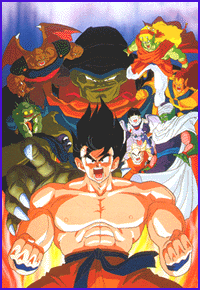Plot
Gohan visits Piccolo and shows him a new tune he has learned to whistle. Due to his advanced Namekian hearing, this causes Piccolo pain; he angrily orders Gohan to stop when they both sense an approaching threat from outer space. Bulma and her father discover that a meteor harboring lifeforms is heading toward the Earth and will destroy the planet upon impact. Amidst mass panic, Goku and Krillin rush to intercept the meteor and hope to push it away by blasting it with ki, but they are both rendered unconscious by the force of the meteor, and it seemingly explodes in orbit. A spaceship then lands in one of Earth's cities.
An army of humanoid alien soldiers exits the ship and declares the Earth under the rule of their leader, Lord Slug. The soldiers attack a group of civilians, but Gohan arrives to defend them. Lord Slug observes that Gohan has a magical Dragon Ball sewn onto his hat, which he loses during the scuffle. After his henchmen render Gohan unconscious and reveal the plan to convert the planet into a biological spaceship, Slug appears and uses telepathy to read Bulma's mind; he learns about her radar used for tracking the Dragon Balls. Slug's men successfully gather the Dragon Balls and summon the eternal dragon Shenron, who grants Slug eternal youth. Meanwhile, life on Earth begins to perish.
Goku and Krillin are revived by Yajirobe. Gohan, meanwhile, resumes his assault against Slug's army; he is nearly killed but is rescued by Piccolo. Piccolo kills the henchman Wings, while Gohan is overwhelmed by Medamatcha. Piccolo is injured when he jumps before a ki blast intended to kill Gohan. Goku and Krillin arrive, and Goku quickly kills Medamatcha and Angila. Slug appears and is attacked by Krillin, who is quickly defeated. Goku fights Slug but is overwhelmed; in a moment of rage, Goku seemingly accesses a portion of the Super Saiyan form.
During the battle, Slug reveals his Namekian heritage. Through telepathy, King Kai warns Goku that Slug is a "Super Namekian", a bloodline of violent warriors obsessed with power. Slug assumes a giant form and crushes Goku between his massive hands. Piccolo intervenes to rescue Goku, and before he is crushed, he tears off his ears and calls out for Gohan to start whistling. The whistling deafens and weakens Slug, allowing Piccolo to transfer his remaining ki to Goku, who powers up and manages to fly straight through Slug's abdomen and incapacitates him. Goku ascends into the sky and prepares a Spirit Bomb. Goku launches the ki bomb at Slug, which sends him hurtling into his machines, killing him and saving the planet.
This page is based on this
Wikipedia article Text is available under the
CC BY-SA 4.0 license; additional terms may apply.
Images, videos and audio are available under their respective licenses.
